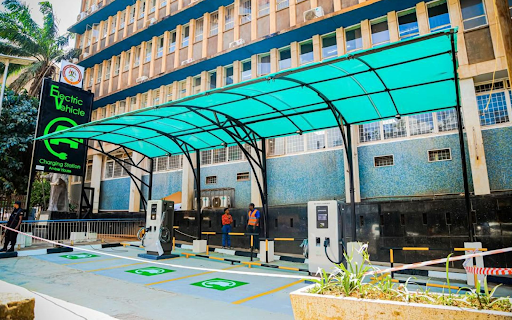The introduction of the electric vehicle charging station in Uganda is a pivotal move toward a sustainable future. Learn about the latest developments in Uganda’s e-mobility transition.
Electric Vehicle Charging Station in Uganda: A Major Step Toward Sustainable Mobility
Uganda has made significant strides in the push for sustainable mobility with the recent launch of its first electric vehicle charging station in Uganda. This marks a critical milestone in the country’s quest for a greener future and the transition to electric vehicles (EVs). Located at Amber House in Kampala, this station is part of Uganda’s broader vision to reduce carbon emissions and foster the adoption of cleaner energy alternatives in transport.
Uganda’s Growing EV Market
The introduction of this electric vehicle charging station in Uganda is a key development, given that the country currently has approximately 3,000 electric vehicles on the roads. While this number is still modest, it represents a growing interest in electric mobility as a sustainable solution to the country’s transport challenges. As the government works to expand the infrastructure, the availability of charging stations is expected to accelerate the adoption of EVs across Uganda.
Aligning with National Energy Goals
Uganda’s commitment to sustainable energy is reflected in its National Electrification Strategy, which aims to provide widespread access to affordable energy. The plan includes reaching 2,000 mini-grids to connect over 230,000 households by 2030. The new electric vehicle charging station in Uganda aligns with these goals, contributing to a greener, more sustainable energy landscape. With 90% of Uganda’s energy coming from renewable sources, the integration of electric mobility supports the country’s efforts to minimize carbon emissions and improve air quality.
Government Commitment to Sustainable Mobility
Ruth Nankabirwa, Uganda’s Minister of Energy and Mineral Development, emphasized the importance of electric mobility in achieving a cleaner, more sustainable future. She highlighted the numerous benefits of EVs, including lower fuel costs, reduced maintenance expenses, and the overall positive environmental impact. The government’s push for electric vehicle charging stations in Uganda demonstrates a strong commitment to supporting the transition toward electric mobility as part of the broader effort to combat climate change and reduce greenhouse gas emissions.
The Ugandan government is actively promoting policies, incentives, and investments to support the growth of the electric vehicle market. With the introduction of fast-charging stations, the government is taking a direct role in advancing sustainable mobility through its energy policy and efficiency initiatives. This initiative also aligns with the country’s broader clean energy policy, which aims to make the most of Uganda’s abundant natural resources.
A Green Future for Uganda’s Transport Sector
The establishment of the electric vehicle charging station in Uganda is just the beginning of a larger movement toward a sustainable, electrified transport system. The government is committed to expanding this infrastructure to ensure that EVs become a practical and accessible option for Ugandans. This transition will not only help reduce the country’s carbon footprint but also position Uganda as a leader in sustainable mobility in Africa.
As the electric vehicle charging station in Uganda network expands, so too will the adoption of electric vehicles, contributing to the country’s green transition and providing a cleaner, more efficient future for transport.
For more updates on Uganda’s journey toward sustainable mobility, visit AutoMag Uganda.
What are your thoughts on the development of electric vehicle charging stations in Uganda?
Share your thoughts in the comments below! We’d love to hear your perspective on how this transition could shape the future of transport in Uganda.




